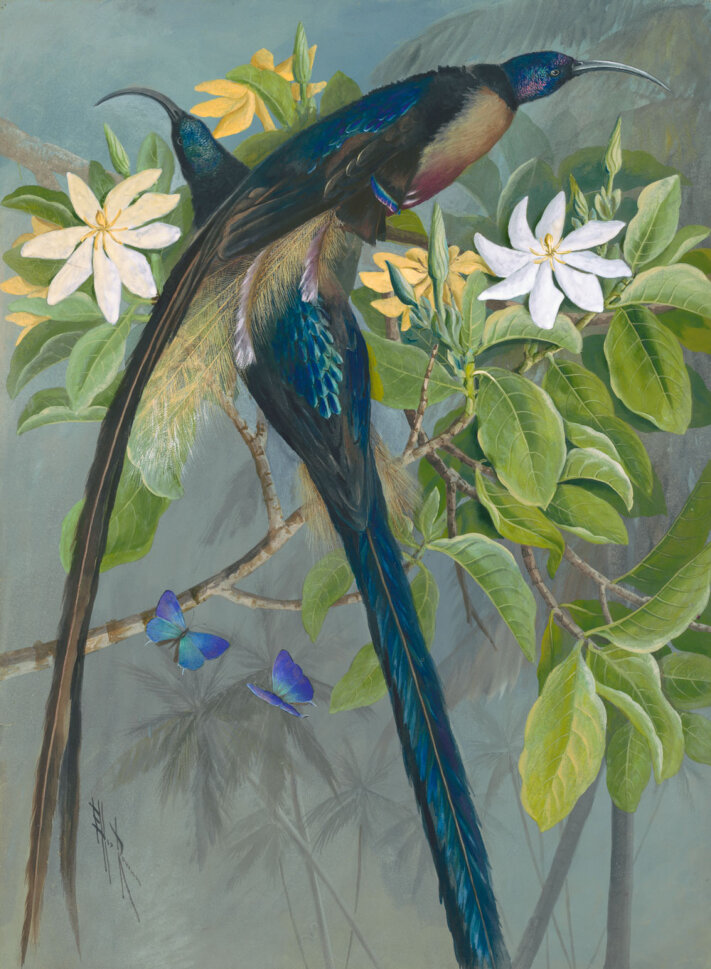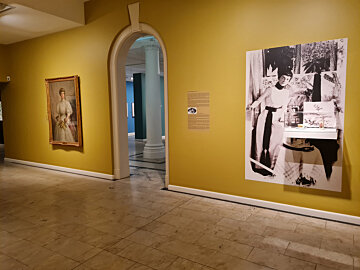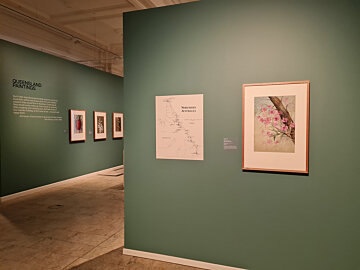Colonialism and Nature Painting was a major exhibition of the works of nineteenth-century artist Ellis Rowan’s Queensland paintings, whose life and artistic practice pushed the boundaries of art, exploration, travel and science in a male dominated art world.
This exhibition forms part of the Cairns Art Gallery online First Nations Research Archive developed as part of the Gallery’s online Legacy Archive produced to celebrate the Gallery’s 30th anniversary.
Born in 1848, Marian Ellis Rowan grew up in Mount Macedon where her father had an extensive European flower garden and was a director of the Royal Botanic Gardens in Melbourne. Rowan’s maternal grandfather, John Cotton, was a fellow of the Zoological Society of London, and painted and documented the birds of the Port Philip area. Flowers and birds, painting and adventure were in her blood.
During the late nineteenth century there was an international generation of trailblazing women. Ellis joined the ranks of female travellers such as Gertrude Bell, Isabella Bird, Mary Kingsley, Alice Lounsberry, Margaret Fountaine and Marianne North – who journeyed on their own to what were for them, foreign and remote places to undertake adventures related in one way or another to European colonial projects.
Between 1883 and 1913, Rowan undertook five separate painting excursions to Queensland, including the Tropical Far North. This exhibition critically examined the circumstances of the production of Rowan’s extensive oeuvre while paying tribute to an exceptional woman who pushed the boundaries of what women could achieve.
The exhibition documented Rowan's remarkable travels from Rockhampton to the Torres Strait and Papua New Guinea, through extraordinary paintings, sketches, diary entries, and photographs, and was presented in partnership with the Queensland Museum.

Colonialism and Nature Painting is an Exhibition Partnership with Queensland Museum Network and National Library Of Australia.
Selected Works
 Ellis ROWAN
1848-1922
Red-plumed Bird of Paradise, 1917
watercolour
75.7 x 50 cm
Ellis Rowan Collection, National Library of Australia
nla.gov.au/nla.obj-138746568
Ellis ROWAN
1848-1922
Red-plumed Bird of Paradise, 1917
watercolour
75.7 x 50 cm
Ellis Rowan Collection, National Library of Australia
nla.gov.au/nla.obj-138746568
 Ellis ROWAN
1848-1922
Broad Leaved Banksia (Banksia robur) 1911
watercolour and gouache on toned wove paper
56.2 x 38.0 cm
Ellis Rowan Collection, Queensland Museum
H20461.53
Ellis ROWAN
1848-1922
Broad Leaved Banksia (Banksia robur) 1911
watercolour and gouache on toned wove paper
56.2 x 38.0 cm
Ellis Rowan Collection, Queensland Museum
H20461.53
 Ellis ROWAN
1848-1922
Wheel of Fire (Stenocarpus sinuatus) 1891-1892
watercolour and gouache on toned wove paper
54.8 x 38.1 cm
Ellis Rowan Collection, Queensland Museum
H20461.85
Ellis ROWAN
1848-1922
Wheel of Fire (Stenocarpus sinuatus) 1891-1892
watercolour and gouache on toned wove paper
54.8 x 38.1 cm
Ellis Rowan Collection, Queensland Museum
H20461.85
 Ellis ROWAN
1848–1922
Brown Sickle-bill Bird-of-paradise (Epimachus Meyeri) with Arhopala sp, Papua New Guinea, 1917
watercolour
76.0 x 55.7 cm
Ellis Rowan Collection, National Library of Australia
nla.gov.au/nla.obj-138748316
Ellis ROWAN
1848–1922
Brown Sickle-bill Bird-of-paradise (Epimachus Meyeri) with Arhopala sp, Papua New Guinea, 1917
watercolour
76.0 x 55.7 cm
Ellis Rowan Collection, National Library of Australia
nla.gov.au/nla.obj-138748316
Installation Images
 Cairns Art Gallery Installation Image
Cairns Art Gallery Installation Image
 Cairns Art Gallery Installation Image
Cairns Art Gallery Installation Image
 Cairns Art Gallery Installation Image
Cairns Art Gallery Installation Image
 Cairns Art Gallery Installation Image
Cairns Art Gallery Installation Image
 Cairns Art Gallery Installation Image
Cairns Art Gallery Installation Image
 Cairns Art Gallery Installation Image
Cairns Art Gallery Installation Image
 Cairns Art Gallery Installation Image
Cairns Art Gallery Installation Image
 Cairns Art Gallery Installation Image
Cairns Art Gallery Installation Image
IMAGE:
Ellis ROWAN 1848-1922
Wheel of Fire (Stenocarpus sinuatus) 1891-1892
watercolour and gouache on toned wove paper
54.8 x 38.1 cm
Ellis Rowan Collection, Queensland Museum
H20461.85
The Cairns Art Gallery acknowledges the Traditional Owners of the land on which we work and live. We pay our respects to Elders past and present. Aboriginal and Torres Strait Islander people should be aware that this website may contain images, names or voices of deceased persons in photographs, film or text.